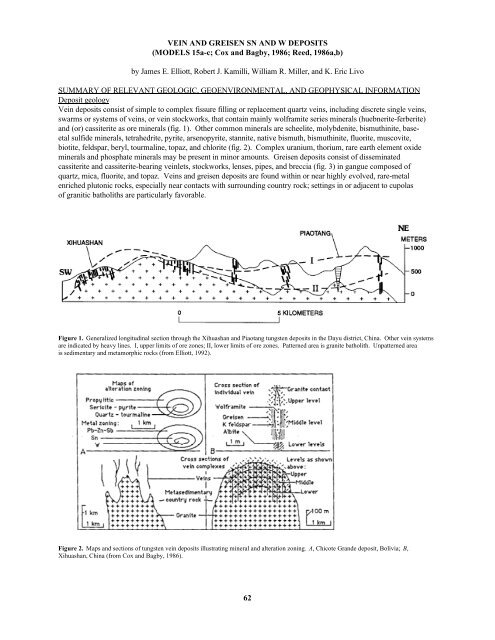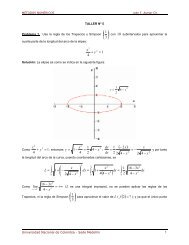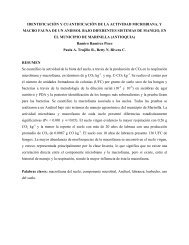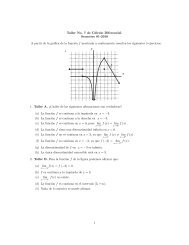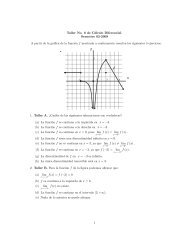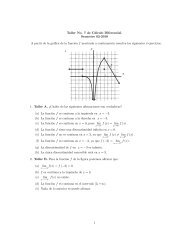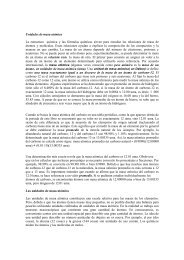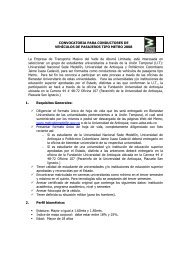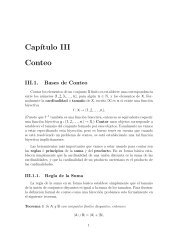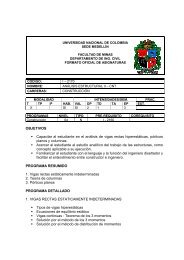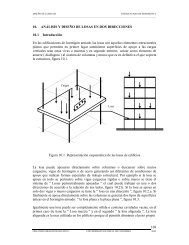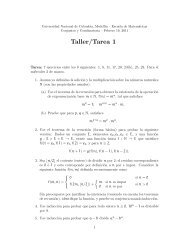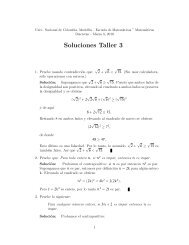62 VEIN AND GREISEN SN AND W DEPOSITS (MODELS 15a-c ...
62 VEIN AND GREISEN SN AND W DEPOSITS (MODELS 15a-c ...
62 VEIN AND GREISEN SN AND W DEPOSITS (MODELS 15a-c ...
You also want an ePaper? Increase the reach of your titles
YUMPU automatically turns print PDFs into web optimized ePapers that Google loves.
<strong>VEIN</strong> <strong>AND</strong> <strong>GREISEN</strong> <strong>SN</strong> <strong>AND</strong> W <strong>DEPOSITS</strong><br />
(<strong>MODELS</strong> <strong>15a</strong>-c; Cox and Bagby, 1986; Reed, 1986a,b)<br />
by James E. Elliott, Robert J. Kamilli, William R. Miller, and K. Eric Livo<br />
SUMMARY OF RELEVANT GEOLOGIC, GEOENVIRONMENTAL, <strong>AND</strong> GEOPHYSICAL INFORMATION<br />
Deposit geology<br />
Vein deposits consist of simple to complex fissure filling or replacement quartz veins, including discrete single veins,<br />
swarms or systems of veins, or vein stockworks, that contain mainly wolframite series minerals (huebnerite-ferberite)<br />
and (or) cassiterite as ore minerals (fig. 1). Other common minerals are scheelite, molybdenite, bismuthinite, baseetal<br />
sulfide minerals, tetrahedrite, pyrite, arsenopyrite, stannite, native bismuth, bismuthinite, fluorite, muscovite,<br />
biotite, feldspar, beryl, tourmaline, topaz, and chlorite (fig. 2). Complex uranium, thorium, rare earth element oxide<br />
minerals and phosphate minerals may be present in minor amounts. Greisen deposits consist of disseminated<br />
cassiterite and cassiterite-bearing veinlets, stockworks, lenses, pipes, and breccia (fig. 3) in gangue composed of<br />
quartz, mica, fluorite, and topaz. Veins and greisen deposits are found within or near highly evolved, rare-metal<br />
enriched plutonic rocks, especially near contacts with surrounding country rock; settings in or adjacent to cupolas<br />
of granitic batholiths are particularly favorable.<br />
Figure 1. Generalized longitudinal section through the Xihuashan and Piaotang tungsten deposits in the Dayu district, China. Other vein systems<br />
are indicated by heavy lines. I, upper limits of ore zones; II, lower limits of ore zones. Patterned area is granite batholith. Unpatterned area<br />
is sedimentary and metamorphic rocks (from Elliott, 1992).<br />
Figure 2. Maps and sections of tungsten vein deposits illustrating mineral and alteration zoning. A, Chicote Grande deposit, Bolivia; B,<br />
Xihuashan, China (from Cox and Bagby, 1986).<br />
<strong>62</strong>
Figure 3. Diagrammatic cross section of a tin greisen (from Reed, 1986b).<br />
Examples<br />
Pasto Bueno, Peru (Landis and Rye, 1974); Panasqueira, Portugal (Kelly and Rye, 1979); Dayu, China (Tanelli, 1982;<br />
Elliott, 1992); Dajishan, China (Elliott, 1992); Cornwall, United Kingdom (Hosking, 1969); Herberton, Australia<br />
(Blake, 1972); Lost River, Alaska, United States (Sainsbury, 1964; Dobson, 1982); Erzgebirge, Czechoslovakia<br />
(Janecka and Stemprok, 1967); Baid al Jimalah and Silsilah, Saudi Arabia (du Bray and others, 1988; Kamilli and<br />
others, 1993).<br />
Spatially and (or) genetically related deposit types<br />
Associated deposit types (Cox and Singer, 1986) include tin skarn (Model 14b), tungsten skarn (Model 14a), tin<br />
replacement deposits (Model 14c), complex tin-silver-sulfide veins, Climax-type molybdenum deposits (Model 16),<br />
and molybdenum vein and greisen deposits (Model 16a, Kotlyar and others, 1995).<br />
Potential environmental considerations<br />
Both tin and tungsten are rare metals and have low abundances in the earth's crust. Consequently, the quantities of<br />
these metals that are mined are much smaller than other metals like copper, lead, and zinc. In addition, the United<br />
States is largely reliant on imports rather than domestic production. For example, in 1993, 81 percent of tin and 84<br />
percent of tungsten consumed in the United States was imported (U.S. Bureau of Mines, 1994).<br />
Potential for significant geoenvironmental impact is minor. Scarce data are available but the environmental<br />
impact is generally dependent on the sulfide mineral content of tungsten and tin ore. The principal ore minerals;<br />
wolframite series, scheelite, and cassiterite; are moderately to highly resistant to physical and (or) chemical<br />
weathering and tend to concentrate in eluvial or alluvial deposits. The mobility of tin in natural environments is low<br />
(Rose and others, 1979). Cassiterite, the principal tin ore mineral, is highly resistant to both chemical and physical<br />
weathering and can be transported long distances from source areas to be concentrated in stream, beach, or marine<br />
placers. The mobility of tungsten is intermediate to low in neutral pH water (Rose and others, 1979) but tungsten<br />
concentrations in alkaline water, including some hot springs and saline lakes (Krauskopf, 1969), may be elevated.<br />
Extraordinary concentrations of 40-64 mg/l tungsten have been reported for brines of Searles Lake, Calif.; hot springs<br />
feeding Searles Lake contain as much as 240 g/l tungsten (Carpenter and Garrett, 1959). The principal ore<br />
minerals, wolframite and scheelite, are similar to cassiterite in resistance to chemical weathering but are somewhat<br />
less resistant than cassiterite to physical weathering. Tungsten ore minerals are brittle and readily break down into<br />
fine particles that disperse into fine-grained sediment. Therefore, tungsten placers are found only near lode sources.<br />
The sulfide mineral content of tin and tungsten ore is generally low and seldom exceeds a few percent. In this ore,<br />
the principal sulfide minerals that have significant acid-generating capacity are pyrite, chalcopyrite, and<br />
arsenopyrite. Host rock and ore may be enriched in molybdenum, thorium, and uranium; these elements may be<br />
63
mobilized in highly acid environments.<br />
The majority of deposits are in terrane consisting of plutonic granitic rocks and pre-intrusive clastic<br />
sedimentary or metasedimentary rocks that have low acid buffering capacity. A potential hazard in regions<br />
containing these types of deposits is the presence of high abundances of radon inside buildings because most of these<br />
deposits are hosted by rock with elevated uranium abundances. For example, in the United Kingdom, the highest<br />
abundances of radon are found in the counties of Cornwall and Devon (Scivyer and others, 1993), a region long<br />
famous for production of tin and tungsten from lode deposits associated with granitic plutons (Hosking, 1969).<br />
Radon is a health hazard in some underground Cornish mines (Dungey and others, 1979).<br />
Mining, milling, and smelting have low to moderate environmental impact. Milling generally involves<br />
gravity, flotation, and magnetic separation; reagents used are generally benign. Concentrates are of high unit value<br />
and can be shipped long distances to processing plants and smelters. Smelters are not particularly harmful but may<br />
release sulfur dioxide.<br />
Exploration geophysics<br />
Magnetic, gravity, and radiometric surveys can be used to define areas in which prospective leucocratic granites may<br />
be present (Hoover and others, 1992). These granites tend to be associated with gravity and magnetic lows and have<br />
elevated radioelement (uranium, thorium, and potassium) abundances. Airborne radiometric surveys may identify<br />
exposed parts of prospective plutons. Remote sensing techniques may help define exposed leucocratic granites or<br />
detect altered areas. At the district or deposit scale and in the less common case of high sulfide ore, audio<br />
magnetotelluric techniques, induced polarization, and electric-field-ratio profiling can be used to map variations in<br />
rock resistivity due to sulfide mineral content.<br />
References<br />
Hosking (1969), Kelly and Rye (1979), Cox and Bagby (1986), Reed (1986a,b), du Bray and others (1988), and<br />
Elliott (1992).<br />
GEOLOGIC FACTORS THAT INFLUENCE POTENTIAL ENVIRONMENTAL EFFECTS<br />
Deposit size<br />
The most common tungsten vein deposits are quartz-wolframite veins. These range from less than 0.1 to about 10<br />
million metric tonnes of ore containing 0.4 to 1.6 percent WO ; median size and grade is 680,000 metric tonnes and<br />
3<br />
0.81 percent WO (Menzie and others, 1992). Tin vein deposits range from less than 0.01 to about 10 million metric<br />
3<br />
tons of ore containing 0.5 to 2.5 percent tin; median size and grade is 240,000 metric tonnes and 1.3 percent tin<br />
(Menzie and Reed, 1986a). Tin greisen deposits are generally larger than tin or tungsten vein deposits and range<br />
from about 0.8 to 70 million metric tons containing 0.2 to 0.5 percent tin; median size and grade is 7.2 million<br />
metric tonnes and 0.28 percent tin (Menzie and Reed, 1986b).<br />
Although the size of individual deposits may be small to moderate, the tendency of these deposits to cluster<br />
can profoundly affect the environment, economy, and culture of a region, as in Cornwall, U.K.; Dayu district, Jiangxi<br />
Province, China; and the Erzgebirge, Czechoslovakia and Germany.<br />
Host rocks<br />
Tin and tungsten deposits exhibit a close spatial association with granitic plutonic rocks, especially late-stage, highly<br />
evolved, specialized biotite and (or) muscovite (S-type or A-type) granites and leucogranites. Small to moderatesized<br />
cupolas of larger subsurface plutons are especially favorable hosts; deposits may be endo- or exocontact.<br />
Exocontact deposits usually are in pelitic and arenaceous sedimentary or metamorphic rocks and within the contact<br />
metamorphic aureole of a pluton. Most endocontact deposits, including tin greisens, and many tin and tungsten veins,<br />
are in or near cupolas and ridges developed on the roof or along margins of granitoids.<br />
Surrounding geologic terrane<br />
Surrounding terrane is variable but generally dominated by felsic plutonic rocks and sequences of pelitic/arenaceous<br />
sedimentary or metamorphic rocks. Regions with tin and tungsten deposits, such as southeastern China, commonly<br />
have a geologic history of multiple orogenic and tectonic events. Genesis of highly-evolved specialized granites<br />
associated with tin-tungsten deposits often involves several stages of magmatism. Regional structures may localize<br />
emplacement of favorable granitoids, whereas local structures, including faults and breccia zones, may localize ore<br />
deposition.<br />
64
Wall-rock alteration<br />
Alteration directly associated with ore includes greisenization, albitization, and (or) tourmalinization. Greisen is a<br />
type of phyllic alteration (including sericitic) characterized by Li-F-bearing micas, topaz, tourmaline, fluorite, and<br />
quartz. Kaolinization, a type of argillic alteration, is widespread in parts of Cornwall, U.K. Silicification is also<br />
important, especially in the contact aureoles of granitic plutons and cupolas. Other alteration types include<br />
microclinization, chloritization, and hematization. Zoned alteration has been identified in some tungsten vein<br />
systems, including the Xihuashan mine, Dayu district, China, where upper parts of veins have well developed greisen<br />
zones; middle parts have quartz-rich greisen and silicification; and lower parts have K-feldspar-rich greisen. Higher<br />
tungsten grades are found in the upper and middle portions of veins (Wu and Mei, 1982).<br />
Most alteration assemblages associated with tin and tungsten vein and greisen deposits have low acid<br />
buffering capacity. Zones of chloritic or feldspathic alteration, usually minor in extent, have low to moderate acid<br />
buffering capacity.<br />
Nature of ore<br />
Most vein deposits consist of individual veins or sets of veins that are individually minable. Some mines and<br />
districts contain hundreds of such veins. The mineralized zone at the Xihuashan mine in the Dayu district, China,<br />
consists of more than 650 veins arranged in three sets of steeply dipping parallel veins (Elliott, 1992). The veins<br />
have an average thickness of 0.4 m (maximum of 3.6 m), average length of 150 m (maximum of 1,075 m), and<br />
vertical extent of about 250 m. Other deposits consist of bulk-minable vein stockworks, as do some parts of the<br />
tungsten deposit at Baid al Jimalah in Saudi Arabia (Kamilli and others, 1993) and the Hemerdon deposit in U.K.<br />
(Mining Magazine, 1979). Some are truly disseminated in greisenized granite cupolas, such as Silsilah tin deposit<br />
in Saudi Arabia (du Bray and others, 1988). Less commonly, tin greisens may have the form of pipes, lenses, or<br />
irregular breccia zones.<br />
Deposit trace element geochemistry<br />
Most tin and tungsten vein and greisen deposits have a close spatial association with highly evolved peraluminous,<br />
S-type, A-type, ilmenite series, or metallogenically specialized granitic rocks. These granites have high contents of<br />
specific rare elements (F, Rb, Li, Sn, Be, W, and Mo) relative to normal granites. They may also have elevated<br />
concentrations of B, Nb, Ta, U, Th, and REE. Mineralized veins and greisens are usually extremely enriched in<br />
lithium, fluorine, rubidium, boron, and beryllium and also contain sulfide and sulfosalt minerals of Cu, Pb, Zn, Bi,<br />
Ag, As, and Sb. Their sulfur and heavy metal contents, however, are usually small.<br />
Ore and gangue mineralogy and zonation<br />
Minerals listed in decreasing order of abundance; potentially acid-generating minerals underlined.<br />
Tungsten: Vein mineralogy varies from simple, consisting almost entirely of quartz and wolframite, to complex as<br />
at Pasto Bueno, Peru, and Panasqueira, Portugal. At Pasto Bueno, the principal vein minerals are wolframite,<br />
tetrahedrite-tennanite, sphalerite, galena, and pyrite in a gangue of quartz, fluorite, sericite, and carbonate. Minor<br />
amounts of molybdenite, chalcopyrite, bornite, arsenopyrite, enargite, stolzite, scheelite, zinnwaldite, topaz, tungstite,<br />
and native arsenic are present (Landis and Rye, 1974). At Panasqueira, more than 50 vein-forming minerals,<br />
including sulfide, sulfosalt, oxide, carbonate, silicate, phosphate, and tungstate minerals, have been identified (Kelly<br />
and Rye, 1979). In general, the most common minerals in tungsten vein deposits in addition to quartz are:<br />
wolframite, molybdenite, bismuthinite, pyrite, pyrrhotite, arsenopyrite, bornite, chalcopyrite, scheelite, cassiterite,<br />
beryl, mica, and fluorite.<br />
Studies of zoning and paragenesis in many tungsten vein deposits (Landis and Rye, 1974; Kelly and Rye,<br />
1979; Wu and Mei, 1982) indicate that, in general, tungsten minerals form earlier, at higher temperatures, and<br />
possibly closer to an igneous source than sulfide and carbonate minerals. A general mineral precipitation sequence<br />
from silicate to oxide, sulfide, and finally carbonate minerals is common to many deposits.<br />
Tin: The mineralogy of tin vein deposits is extremely varied and complex, especially where sulfide and sulfosalt<br />
minerals are present. The most common minerals are cassiterite, wolframite, arsenopyrite, molybdenite, hematite,<br />
scheelite, beryl, galena, chalcopyrite, sphalerite, stannite, and bismuthinite in addition to ubiquitous quartz.<br />
The Cornwall region (U.K.) is frequently cited as one of the classic areas of ore zoning, with Sn, Cu, Pb-Zn,<br />
Fe-(Mn, Sb) zones distributed sequentially around individual intrusive centers and arranged according to depth to<br />
granite contacts. The zones are roughly parallel to granite-metasediment contacts and may represent paleoisogeother<br />
mal surfaces (Guilbert and Park, 1986). The tin zone, the deepest zone, is generally found from depths of about<br />
65
1,300 m within the granite to a short distance outside the granite contacts in metasedimentary rocks (Guilbert and Park,<br />
1986).<br />
In most greisen deposits, polyphase mineralization and multiple mineralizing centers control ore distribution<br />
and render identification of zoning patterns quite difficult. Nevertheless, the idealized disseminated greisen deposit<br />
associated with an individual cupola is zoned with respect to distributions of Sn, Mo, As, Bi, W, Be, Ag, Pb, and<br />
Zn (Hosking, 1969; Reed, 1986b). Abundances of elements toward the beginning of this list are greatest in<br />
hydrothermally altered rocks nearest mineralized cupolas, whereas abundances of elements toward the end of the list<br />
are greatest in distal parts of mineralized areas. Alteration zoning consists of albitization below the ore; pervasive<br />
greisenization with quartz-muscovite-topaz ± fluorite ± tourmaline; and chloritic alteration. Pyrite and arsenopyrite<br />
are common in the strongly greisenized zones. In addition to cassiterite and wolframite, other minerals include<br />
molybdenite, bismuthinite, native bismuth, pyrrhotite, bornite, chalcopyrite, scheelite, beryl, tetrahedrite-tennanite,<br />
sphalerite, galena, enargite, hematite, stannite, sulphostannates, siderite, and calcite. Complex uranium, thorium, rare<br />
earth element oxide and phosphate minerals are commonly present in minor amounts.<br />
Mineral characteristics<br />
Tin-tungsten veins are commonly coarse-grained; grain sizes as much as several cm are common and, in the Dajishan<br />
mine, China, wolframite crystals up to 1 m in length are found in quartz veins (Elliott, 1992). Very large wolframite<br />
crystals are also present at deposits in eastern Nevada. Ore and gangue minerals in tin greisens are finer-grained.<br />
Quartz is the most common gangue mineral in both veins and greisen and may account for 90 percent or more of<br />
vein fillings. Ore and gangue minerals other than quartz are commonly enclosed or capsulated by quartz thus<br />
protecting them from oxidation and weathering by surface and ground water. Post-mineralization faults, however,<br />
may expose ore and gangue, including sulfide minerals, to oxidation and solution in mine water.<br />
Secondary mineralogy<br />
Secondary tin and tungsten minerals are rare and, if present, have limited geoenvironmental impact. Varlamoffite<br />
((Sn,Fe)(O,OH) ), a complex oxidation product of stannite, has been reported from numerous localities. The<br />
2<br />
oxidation and weathering of wolframite or scheelite deposits can produce small amounts of tungstite (WO ·H O) and<br />
3 2<br />
(or) ferritungstite ((W,Fe)(O,OH) ). Where the sulfide and (or) sulfosalt mineral content is high oxidation and<br />
3<br />
weathering may result in the formation of secondary and supergene minerals, some of which, including goethite,<br />
limonite, jarosite, chalcanthite, and others, are soluble (underlined).<br />
Topography, physiography<br />
Tin and tungsten vein and greisen deposits are found in areas of varied topography. Granitic plutonic rocks<br />
associated with these deposits tend to form positive areas of moderate to high relief. Silica-rich rocks such as<br />
greisens, stockwork vein zones, and quartz veins form knobs or linear ridges in areas of low relief.<br />
Hydrology<br />
Tin and tungsten veins and greisens are commonly vuggy and are zones of high permeability relative to surrounding<br />
granitic or metasedimentary rocks. In addition, post-mineralization faulting may follow veins and large, individual<br />
veins may contain major water courses, making control of mine drainage a potential problem.<br />
Mining and milling methods<br />
Mining: Tin and tungsten veins and greisens are mined by conventional underground and open-pit methods. Most<br />
production is probably from underground mines because of the relative small size, narrow widths, and depths of<br />
orebodies. Cut-and-fill stoping and open stoping are probably most common underground methods.<br />
Ore dressing: Tungsten--Gravity and flotation, using organic compounds, methods are most commonly used.<br />
Xanthate collectors are used to float sulfide minerals from scheelite ore; subsequently, fatty acids and soaps are used<br />
to float scheelite. Fatty acids are also used to float wolframite. Magnetic and electrostatic methods are also used.<br />
Magnetic methods are used to separate wolframite and cassiterite. Tin--Gravity is only practical way of preparing<br />
cassiterite concentrates. Complex sulfide ore that contains a significant amount of tin in sulfide or sulfosalt minerals<br />
requires special treatment that may involve flotation.<br />
Because of the friable nature of both tin and tungsten minerals, a significant amount of these minerals may be lost<br />
in finer grained material (slime) during milling. Care must be exercised in the initial crushing, grinding, and<br />
first-stage separation to prevent excessive sliming.<br />
66
Metallurgy: Tungsten--Tungsten concentrates, containing approximately 60-65 percent WO (scheelite), can be<br />
3<br />
combined with coke and steel in an electric furnace and reduced to ferrotungsten; alternatively, concentrates can be<br />
treated chemically to produce intermediate products or tungsten metal (as powder). Because of tungsten's high<br />
melting temperature (3,400°C), chemical decomposition and purification are used, instead of pyrometallurgy, to<br />
produce tungsten metal. This process involves three steps: (1) decomposition of tungsten minerals, (2) purification<br />
of tungstic oxide, and (3) production of metal powder (Li and Wang, 1955). Most current production, trade, and<br />
consumption of tungsten, however, involves an intermediate product called ammonium paratungstate (APT). The<br />
preparation of APT is a chemical process involving calcination, pressure digestion, filtration and purification, solvent<br />
extraction, and crystallization (Lassner, 1982). Tin--Smelting tin from cassiterite concentrates generally involves<br />
either a (1) carbo-thermic process of heating tin concentrate with carbon or (2) fuming process in which tin<br />
concentrate is heated with sulfur or sulfide minerals to volatilize stannous sulfide. A chloride volatilization process<br />
is also used in tin smelting (Harris, 1979).<br />
ENVIRONMENTAL SIGNATURES<br />
Drainage signatures<br />
Because of the low solubility of tin and tungsten minerals, high values in water are not expected. In the unusual<br />
case, in which the primary ore sulfide mineral content is high, highly acidic water with elevated abundances of iron,<br />
aluminum, fluorine, and variable copper and zinc may characterize drainage from mines or mine wastes. Highly acid<br />
water can also mobilize fluorine and uranium, whose abundances are commonly elevated in tin and tungsten ore.<br />
Metal mobility from solid mine wastes<br />
In general, metal mobilities from solid mine wastes are low. When the sulfide and (or) sulfosalt mineral content of<br />
ore is moderate to high, metal mobilities increase due to production of low pH water and formation of soluble<br />
secondary minerals.<br />
Soil, sediment signatures prior to mining<br />
Soil and stream sediment may have elevated tin and tungsten contents (tens to hundreds of ppm) and may contain<br />
anomalous abundances of elements characteristic of specialized granites (F, Rb, Be, Nb, Ta, Mo, U, Th, Li, and<br />
REE). Other possible pathfinder elements are As, Bi, B, Cu, Pb, and Zn.<br />
Potential environmental concerns associated with mineral processing<br />
Potential hazards include:<br />
(1) High silica dust blowing from unstable mill tailings.<br />
(2) Possible high concentrations of U, Th, Be, Mo, As, P, and REE in mill tailings and smelter waste due to primary<br />
enrichments of these elements in host rock and ore and the gravity and magnetic separation methods used in milling,<br />
which concentrate high specific gravity minerals.<br />
(3) Waste from APT process includes alkaline effluents and residues containing Mo, P, As, U, Th, and REE (Raddatz<br />
and others, 1988).<br />
Smelter signatures<br />
Tin smelters may release sulfur dioxide and other volatile elements, including arsenic, fluorine, chlorine, and others,<br />
present in ore or used in smelting process.<br />
Climate effects on environmental signatures<br />
The effects of various climatic regimes on the geoenvironmental signature specific these deposits are not known.<br />
However, in most cases the intensity of environmental impact associated with sulfide-bearing mineral deposits is<br />
greater in wet climates than in dry climates. Acidity and total metal concentrations in mine drainage in arid<br />
environments are several orders of magnitude greater than in more temperate climates because of the concentrating<br />
effects of mine effluent evaporation and the resulting "storage" of metals and acidity in highly soluble metal-sulfatesalt<br />
minerals. However, minimal surface water flow in these areas inhibits generation of significant volumes of highly acidic,<br />
metal-enriched drainage. Concentrated release of these stored contaminants to local watersheds may<br />
be initiated by precipitation following a dry spell.<br />
67
Geoenvironmental geophysics<br />
Audio magnetotelluric techniques, induced polarization, and electric-field-ratio profiling can be used to detect<br />
hydrothermally altered areas and the presence of ground water. Gamma ray spectroscopy can be used to measure<br />
uranium and thorium abundances and radon can be determined by several special collectors used in conjunction with<br />
laboratory analysis.<br />
REFERENCES CITED<br />
Blake, D.H., 1972, Regional and economic geology of the Herberton-Mount Garnet area, Herberton tinfield, North<br />
Queensland: Australia Bureau of Mineral Resources Bulletin 124, 265 p.<br />
Carpenter, L.C., and Garrett, D.E., 1959, Tungsten in Searles Lake: Mining Engineering, v. 11, p. 301-303.<br />
Cox, D.P., and Bagby, W.C., 1986, Descriptive model of W veins, in Cox, D.P., and Singer, D.A., eds., Mineral<br />
deposit models: U.S. Geological Survey Bulletin 1693, p. 64.<br />
Cox, D.P., and Singer, D.A., 1986, Mineral deposit models: U.S. Geological Survey Bulletin 1693, 379 p.<br />
Dobson, D.C., 1982, Geology and alteration of the Lost River tin-tungsten-fluorine deposit, Alaska: Economic<br />
Geology, v. 77, p. 1033-1052.<br />
du Bray, E.A., Elliott, J.E., and Stuckless, J.S., 1988, Proterozoic peraluminous granites and associated Sn-W<br />
deposits, Kingdom of Saudi Arabia, in Taylor, R.P., and Strong, D.F., eds., Recent advances in the geology<br />
of granite-related mineral deposits: Canadian Institute of Mining and Metallurgy, special volume 39, p. 142-<br />
156.<br />
Dungey, C.J., Hore, J., and Waller, M.D., 1979, An investigation into control of radon and its daughter products in<br />
some Cornish mine atmospheres: Transactions of the Institute of Mining and Metallurgy, v. 88, p. A35-A43.<br />
Elliott, J.E., 1992, Tungsten- geology and resources of deposits in southeastern China, in DeYoung, J.H., Jr., and<br />
Hammarstrom, J.M., eds., Contributions to commodity geology research: U.S. Geological Survey Bulletin<br />
1877, p. I1-I10.<br />
Guilbert, J.M., and Park, C.F., Jr., 1986, The geology of ore deposits: W.H. Freeman and Co., New York, 985 p.<br />
Harris, J.H., 1979, The problems of tin, in Lead, Zinc, Tin '80: The Metallurgical Society of AIME, Warrendale,<br />
PA., p. 733-753.<br />
Hoover, D.B., Heran, W.D., and Hill, P.L., 1992, The geophysical expression of selected mineral deposit models:<br />
U.S. Geological Survey Open-File Report 92-557, 129 p.<br />
Hosking, K.F.G., 1969, The nature of primary tin ores of the south-west of England, in A Second Technical<br />
Conference on Tin: Bangkok, International Tin Council, v. 1, p. 21-83.<br />
Janecka, J., and Stemprok, M., 1967, Endogenous tin mineralization in the Bohemian massif, in A Technical<br />
Conference on Tin: London, International Tin Council, v. 1, p. 245-266.<br />
Kamilli, R.J., Cole, J.C., Elliott, J.E., and Criss, R.E., 1993, Geology and genesis of the Baid al Jimalah tungsten<br />
deposit, Kingdom of Saudi Arabia: Economic Geology, v. 88, no. 7, p. 1743-1767.<br />
Kelly, W.C., and Rye, R.O., 1979, Geologic, fluid inclusion, and stable isotope studies of the tin-tungsten deposits<br />
of Panasqueira, Portugal: Economic Geology, v. 74, p. 1721-1822.<br />
Kotlyar, B.B., Ludington, Steve, and Mosier, D.L., 1995, Descriptive, grade, and tonnage models for molybdenumtungsten<br />
greisen deposits: U.S. Geological Survey, Open-File Report 95-584, 30 p.<br />
Krauskopf, K.B., 1969, Tungsten (Wolfram), in Handbook of Geochemistry, Springer-Verlag, v. II/2, p. 74-B to 74-<br />
O.<br />
Landis, G.P., and Rye, R.O., 1974, Geologic, fluid inclusion, and stable isotope studies of the Pasto Bueno tungstenbase<br />
metal ore deposit, northern Peru: Economic Geology, v. 69, p. 1025-1059.<br />
Lassner, Erik, 1982, Modern methods of APT processing, in Tungsten; 1982, Proceedings of the Second International<br />
Tungsten Symposium, June 1982: Mining Journal Books, Ltd., p. 71-80.<br />
Li, K.C., and Wang, C.Y., 1955, Tungsten: Reinhold, New York, 506 p.<br />
Menzie, W.D., Jones, G.M., and Elliott, J.E., 1992, Tungsten- grades and tonnages of some deposits, in DeYoung,<br />
J.H., Jr., and Hammarstrom, J.M., eds., Contributions to commodity geology research: U.S. Geological<br />
Survey Bulletin 1877, p. J1-J7.<br />
Menzie W.D., and Reed, B.L., 1986a, Grade and tonnage model of Sn veins, in Cox, D.P., and Singer, D.A., eds.,<br />
Mineral deposit models: U.S. Geological Survey Bulletin 1693, p. 67-69.<br />
_________1986b, Grade and tonnage model of greisen Sn deposits, in Cox, D.P., and Singer, D.A., eds., Mineral<br />
deposit models: U.S. Geological Survey Bulletin 1693, p. 71-72.<br />
Mining Magazine, 1979, Hemerdon- Britain's largest tungsten deposit: Mining Magazine, October, p. 342-351.<br />
68
Raddatz, A.E., Gomes, J.M., and Carnahan, T.G., 1988, Preparation of ammonium paratungstate from a sodium<br />
tungstate-sodium chloride phase: U.S Bureau of Mines, Report of Investigations 9165, 10 p.<br />
Reed, B.L., 1986a, Descriptive model of Sn veins, in Cox, D.P., and Singer, D.A., eds., Mineral deposit models:<br />
U.S. Geological Survey Bulletin 1693, p. 67.<br />
_________1986b, Descriptive model of Sn greisen deposits, in Cox, D.P., and Singer, D.A., eds., Mineral deposit<br />
models: U.S. Geological Survey Bulletin 1693, p. 70.<br />
Rose, A.W., Hawkes, H.E., and Webb, J.S., 1979, Geochemistry in mineral exploration: Academic Press, 657 p.<br />
Sainsbury, C.L., 1964, Geology of the Lost River mine area, Alaska: U.S. Geological Survey Bulletin 1287, 101 p.<br />
Scivyer, Chris, Woolliscroft, Michael, and Parkins, Lynn, 1993, The development and implementation of radon<br />
protective measures in UK dwellings, in The 1993 International Radon Conference, supp. #2: The American<br />
Association of Radon Scientists and Technologists, September, 1993, Denver, Colo., 5 p.<br />
Tanelli, G., 1982, Geological setting, mineralogy and genesis of tungsten mineralization in Dayu district, Jiangxi<br />
(People's Republic of China), an outline: Mineralium Deposita, v. 17, no. 2, 279-294.<br />
U.S. Bureau of Mines, 1994, Mineral Commodity Summaries 1994, 201 p.<br />
Wu Yongle and Mei Yong Wen, 1982, Multi-phase intrusion and multi-phase mineralization in Xihuashan tungsten<br />
ore field, in Hepworth, J.V., and Yu Hong Zhang, eds., Tungsten geology, Jiangxi, China: Bandung,<br />
Indonesia, ESCAP/RMRDC, p. 437-449.<br />
69


